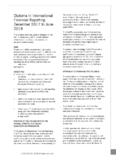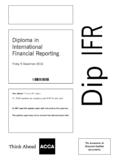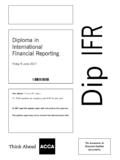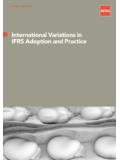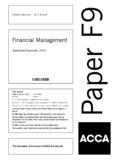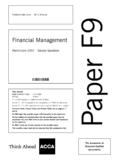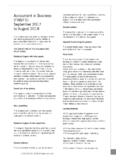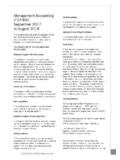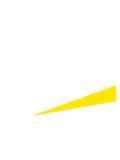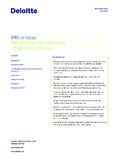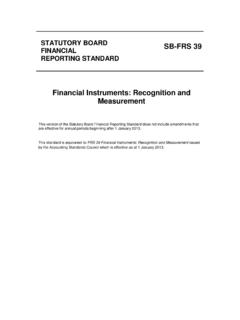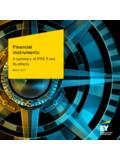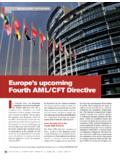Transcription of Answers - ACCA Global
1 AnswersProfessional Level Essentials Module, Paper P2 (INT)Corporate Reporting (International)December 2013 Answers1(a)Angel GroupStatement of cash flows for the year ended 30 November 2013$mProfit for the year (W1)197 Adjustments to operating activitiesFinancial assets profit on sale (W5)(14)Retirement benefit expense (W7)10 Depreciation (W1)29 Profit on sale of PPE (W1)(14)Associate s profit (W3)(12)Impairment of goodwill and intangible assets (26 5 + 90) (W6)116 5 Finance costs10 322 5 Movements in working capitalDecrease in trade receivables (180 125 + 3)58 Decrease in inventories (190 155 + 6)41 Decrease in trade payables (361 155 + 4)(210) Cash generated from operating activities211 5 Cash paid to retirement benefit scheme (W7)(9)Interest paid (10)Income taxes paid (W4)(135 5) Net cash generated by operating activities57 Cash flows from investing activitiesSale of financial assets (W5)40 Purchase of financial assets (57)Purchase of property, plant and equipment (PPE) (W1)(76)Cash grant for PPE (W1)1 Purchase of subsidiary (30 2) (W2)(28)Proceeds from sale of PPE (W1)63 Dividend received from associate (W3)3 Purchase of associate (W3)(71) Net cash flows used by investing activities(125) Cash flows from financing activitiesProceeds of issue of share capital225 Repayment of long-term borrowings(31)Dividends paid(10)Non-controlling interest dividend (6) Net cash generated by financing activities178 Net increase in cash and cash equivalents 110 Cash and cash equivalents at beginning of period355 Cash and cash equivalents at end of period465 WorkingsWorking 1 Property, plant and equipment building renovationThe following transactions would need to be made to recognise the asset in the entity s statement of financial position as of 30 November Property, plant and equipment $7mCr OCI$4mCr Retained earnings (to correct)
2 $3mThe accounting policy of the Angel Group is to treat capital-based grants as deferred income. However, the grant of $2m relates to capital expenditure and revenue. The grant should be split equally over revenue correcting entries should therefore be:Dr PPE$2mCr Retained earnings$1mCr Deferred income (long-term liabilities)$1m13 Thus from a cash flow perspective, net profit before taxation should be adjusted by $3 million and additions to PPE increasedby $3 million. Additionally, cash flows from investing activities should show the grant received of $1 million, net profit beforetaxation should increase by $1 million and additions to PPE increase by $2 carrying amount of PPE before adjustments$mOpening balance at 1 December 2012465 Revaluation8 Additions66 Disposals(49)Subsidiary acquisition14 Depreciation(29) Closing balance at 30 November 2013475 Additions for the year are $66m above, plus the adjustments re the grant and building of $3 million and $2 million and theconstruction costs of $5 million, $76 profit before tax will be $188 million + $3 million + $1 million (grant) + $1 million capitalised interest + $4 millionconstruction costs charged to other expenses, $197 2 Purchase of subsidiaryThe purchase of the subsidiary is adjusted for in the statement of cash flows by eliminating the assets and liabilities acquired,as they were not included in the opening balances.
3 The fair values will be used, as they will be the values utilised of deferred tax arising on acquisition:$mFair values of Sweety s identifiable net assets excluding deferred tax20 Lesstax base(15) Temporary difference arising on acquisition5 Net deferred tax liability arising on acquisition (30% x $5m)1 5 Calculation of goodwill:$mPurchase consideration30 Fair value of net assets (net of deferred tax)(20)Deferred taxation1 5 Goodwill arising on acquisition11 5 Working 3 Associate$mBalance at 30 November 201380 Lessprofit for period $40m x 30%(12)Adddividend received $10m x 30%3 Cost of acquisition (cash)71 Therefore, cash paid for the investment is $71 million, and cash received from the dividend is $3 million. Working 4 Taxation$m$mOpening tax balances at 1 December 2012 Deferred tax31 Current tax138 169 Charge for year 46 Deferred tax on acquisition (W2)1 5 Tax on revaluation PPE2 Tax on financial assets1 Less closing tax balances at 30 November 2013:Deferred tax35 Current tax49 (84) Cash paid135 5 14 Working 5 financial assetsThe sale proceeds of the financial assets were $40 million.
4 Thus, an adjustment for the profit of $14 million on the sale ofthe financial assets has to be made. The deferred tax of $1 million arose on the gain on 6 Goodwill$mOpening balance at 1 December 2012120 Current year amount on subsidiary (W2)11 5 Impairment(26 5) Closing balance at 30 November 2013105 Impairments of other intangibles ($240m 150m) $90m + $26 5m = $116 5mWorking 7 Retirement benefit$mOpening balance at 1 December 201274 Remeasurement actuarial losses4 Current year service cost plus interest11 Contributions paid(9) Closing balance at 30 November 201380 An adjustment has to be made in the statement of cash flow for the current year amount ($11 million) and the purchase ofthe subsidiary ($1 million), giving a net adjustment of $10 million.(b)There are two classification principles which could be used to determine the classification of cash flows. Cash flows can beclassified in accordance with the nature of the activity to which they relate which is most appropriate to the business of theentity, or cash flows can be classified consistently with the classification of the related or underlying item in the statement offinancial position.
5 Generally speaking, cash flows in IAS 7 should be classified in accordance with the nature of the activityto which they relate which is the most appropriate to the business of the following elements could be used to help identify the nature of the cash flows being analysed: the cause or reason for which the cash flow is received or paid, the counterparty who receives or pays the cash flow, whether cash flows result from transactions which enter into the determination of profit or loss, or the predominant source of cash statement of cash flows analyses changes in cash and cash equivalents during a period. Cash and cash equivalentscomprise cash in hand and demand deposits, together with short-term, liquid investments which are readily convertible to aknown amount of cash and which are subject to an insignificant risk of changes in value. IAS 7 does not define short term but does state an investment normally qualifies as a cash equivalent only when it has a short maturity of, say, three monthsor less from the date of acquisition.
6 Consequently, equity or other investments which do not have a maturity date are excluded from cash equivalents unless theyare, in substance, cash equivalents. This three-month time limit is somewhat arbitrary but is consistent with the concept ofinsignificant risk of changes in value and a purpose of meeting short-term cash commitments. As regards the deposits, the following is the case:(i) Although the principal ($3 million) will be recoverable with early withdrawal, the entity will lose all accumulated interestover the term, which seems to be a significant penalty. The cash is not needed to meet short-term cash commitmentsand so would not qualify as a cash equivalent.(ii) Although the deposit is stated to have a 12-month maturity period, it can be withdrawn with 21 days notice. Althoughthis incurs a penalty, the reduction in the rate of interest from 3% to 2% is unlikely to be considered significant. Theintention of management is to keep these funds available for short-term cash needs and so this deposit is likely to qualifyas a cash equivalent.
7 (c)The directors should be persuaded that professional ethics are an inherent part of the profession as well as other majorprofessions such as law and engineering. Professional ethics are a set of moral standards applicable to all professionals. Eachprofessional body has its own ethical code such as the ACCA s Code of Ethics and Conduct, which requires its members toadhere to a set of fundamental principles in the course of their professional duty, such as confidentiality, objectivity,professional behaviour, integrity and professional competence and due care. The main aim of professional ethics is to serve as a moral guideline for professional accountants. By referring back to the setof ethical guidelines, the accountant is able to decide on the most appropriate course of action, which will be in line with theprofessional body s stance on ethics. The presence of a code of ethics is a form of declaration by the professional body to thepublic that it is committed to ensuring the highest level of professionalism amongst its members.
8 15 Often there may be ethical principles which conflict with the profit motive and it may be difficult to decide on a course ofaction. Ethical guidelines can help by developing ethical reasoning in accountants by providing insight into how to deal withconflicting principles and why a certain course of action is desirable. Individuals may hold inadequate beliefs or hold on toinadequate ethical values. An accountant has an ethical obligation to encourage the directors to operate within certainboundaries when determining the profit figure. Users are becoming reactive to unethical behaviour by directors. This is leadingto greater investment in ethical companies with the result that unethical practices can have a greater impact on the value ofan entity than the reporting of a smaller profit figure. Ethical guidelines enable individuals to understand the nature of one sown opinion and ethical values. Ethical guidelines help identify the basic ethical principles which should be applied.
9 This willinvolve not only code-based decisions but also the application of principles which should enable the determination of whatshould be done in a given situation. This should not conflict with the profit motive unless directors are acting guidance gives a checklist to be applied so that outcomes can be determined. Ethical issues are becoming more andmore complex and it is critical to have an underlying structure of ethical reasoning, and not purely be driven by the (a)Havanna s recognition of revenue with respect to the contracts does not comply with IAS 18 Revenue, which requires incomefrom services to be recognised by reference to the stage of completion of the transaction at the end of the reporting 18 states that the rendering of services typically involves the performance by an entity of a contractually agreed task overan agreed period. When the outcome of a transaction involving the rendering of services can be estimated reliably, thestandard requires the revenue to be recognised by reference to the stage of completion of the transaction at the end of thereporting period.
10 This requirement applies to all transactions, irrespective of the length of the contract term. Thus, there is nobasis for Havanna failing to apportion income arising from contracts over the period of the contract. Income from contractswhich extend over two financial reporting periods cannot be recognised in full in the financial year in which they were enteredinto simply because the agreements are deemed to have limited obligations . Havanna has argued that it only assumes limitedobligations under the contract and that this could not be seen as the rendering of IAS 18, income should be recognised on a basis which reflects the extent to which services are performed and onthis basis, the income should be recognised as services are 18 para 25 is also relevant. Where services are performed by an indeterminate number of acts over a specified period oftime, revenue is recognised on a straight-line basis over the specified period unless there is evidence that some other methodbetter represents the stage of completion.
